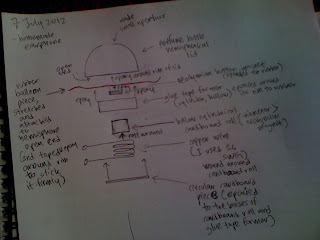Hi, I m back after about 6 -7 months hiatus. Honestly, i was so busy back then due to my final year course here. The exam result will be coming out within a week and I will graduate a month later before returning to my homecountry.
As exam is over and I m now a free, jobless and unemployed in this summer holiday I manage to find some time to return to my delayed project, the FM receiver circuit.
My last post discussed about my generalised FM receiver circuit from lengthy hours of internet research. So far I failed to make an operable single transistor FM receiver although I strictly followed the circuits in the post. However it does not mean that the circuits are wrongly designed, since they were all proven to be operable by the designers who are very professional ( most of them are experienced electronic engineer and hobbyists). Thus I guessed the problems may lie within the component or my lack of hands-on skills, especially in the making of centre-tapped coil ( i m poor at soldering :( .... )
Due to that I continued researching from the internet. From some information gained, I readjusted the circuit without rigorous and analytical calculation (i m not electronic engineer though) but by intuitive manner, and try to avoid centre-tapped coil as possible as I can.
After several try-and-error, I managed to design an operable single transistor FM receiver. Although the signal obtained was quite faint for capacitor feedback than inductor coil feedback (will be mentioned below), its operability is enough to give me a little bit of joy as an amateur inventor. I managed to reach Absolute FM, one of the mainstream radio channel from FM bands in the UK and listen to some of songs I recognised. The signal can be improved by various means, however single transistor receiver is not really about quality (thats why it is not commercially manufactured) you designed it in order to learn the operating principles.
Sorry for not putting any video cuz I have no money to buy a camera, and my laptop webcam's microphone is not working very good to capture faint signal.
The following are the circuit I innovated;
The above circuit used small signal bipolar junction transistor 2N3904, one of the famous small signal transistor most commonly used for demodulation of FM signal (its even explained in Wikipedia). The values of capacitors, inductances and resistances are not strict, if yours are not working then just try changing the values. The RF choke can be used to suppress any high frequency signal from entering the audio amplifier, which is the main cause of unpleasant noise. The grounding must be properly done and the antenna must be long enough so the tune circuit current can flow properly and give out better reception.
The 5pF capacitor between the RF choke and the base of the transistor is the feedback capacitor. You can also use the same inductor as used in the tune circuit ( the 6-turn inductor) as feedback instead of capacitor, and placing both inductors close to each other to achieve resonant by magnetic coupling. I found that the signal was better by using inductors and magnetic coupling.
Another operable design I ve tried was by changing the transistor with JFET, an MPF102 transistor. In contrast with the above design, this time the feedback capacitor was connected to the source and the gate is grounded. However as the above design, the signal was better if using inductor feedback instead of capacitor.
In general the signal was faint and mono although perceivable by human ears. The quality of the sound is low, as expected. As I mentioned before, this type of FM receiver is not made for quality, but for learning purpose. To be honest I learned many things about feedback, FM demodulation and transistor actions from experimenting with this, and still learning. I believe that by learning the basics, then we can move on to improving quality.
Update: I just happened to know that my Iphone can record video. So I tried record the sound produced by the receiver, but unfortunately, the sound was not strong enough to be recorded and it needed high power amplifier to do that. Anyway, the circuit works and amplifier LM386 can gives loud output with earphone but not speaker, and the signal is not strong enough for recording unless amplified with high power amplifier.
Compared to this FM receiver, AM receiver (or crystal radio, as most hobbyist name it) gives loud audio signal, and LM386 audio amplifier suffices to enable this signal to be capture by using mere Iphone recorder. This may be due to the fact that frequency modulation is vulnerable to noise than amplitude modulation. Check out
my video on crystal radio for evidence.




